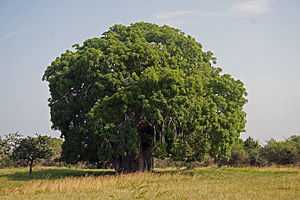Adansonia digitata
| Adansonia digitata | |
|---|---|
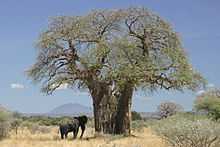 | |
| Baobab tree in Tanzania | |
| Scientific classification | |
| Kingdom: | Plantae |
| (unranked): | Angiosperms |
| (unranked): | Eudicots |
| (unranked): | Rosids |
| Order: | Malvales |
| Family: | Malvaceae |
| Genus: | Adansonia |
| Species: | A. digitata |
| Binomial name | |
| Adansonia digitata L. | |
Adansonia digitata (baobab) is the most widespread of the Adansonia species on the African continent, found in the hot, dry savannahs of sub-Saharan Africa. Common names for the baobab include dead-rat tree (from the appearance of the fruits), monkey-bread tree (the soft, dry fruit is edible), upside-down tree (the sparse branches resemble roots) and cream of tartar tree (cream of tartar).
Discovery
The scientific name of the Baobab, “Adansonia Digitata” comes from the French explorer and botanist, Michel Adanson (1727-1806). He officially discovered it in 1749 on the island of Sor in Senegal.[1] He concluded of all the trees he studied, the Baobab “is probably the most useful tree in all.” He consumed Baobab juice twice a day, while in Africa. He remained convinced that it maintained his health for him. [2] "Digitata" refers to the digits of the hand. The Baobab's branches and leaves are akin to a hand.
Physical Description
All baobab trees are deciduous trees, meaning they lose their leaves in the dry season. They can reach from 5- 25 meters in height. In fact, they are known both for their height and their girth. Its trunk tends to be bottle-shaped and can reach a diameter of 10-14 m.[3]
The trunk is smooth and shiny[4] and can range from being reddish brown to grey. The bark can feel cork-like.[5] The branches are thick and wide and very stout compared to the trunk. It has large, white flowers (12 cm across) that open at night. [6]The flowers have 5 petals that are hairy inside and leathery. The sepals are cup-shaped and 5-cleft. The stamens are divided into multiple anthers and styles are 7-10 rayed. The flowers have a lifespan of about 24 hours.[7]
The baobab is leafless for nine months of the year. Many consider the tree to be “upside-down” due to its trunk likeness to a taproot and the branches akin to the finer capillary roots. The roots of the tree actually span larger than the height. This allows the tree to survive well in a dry climate.
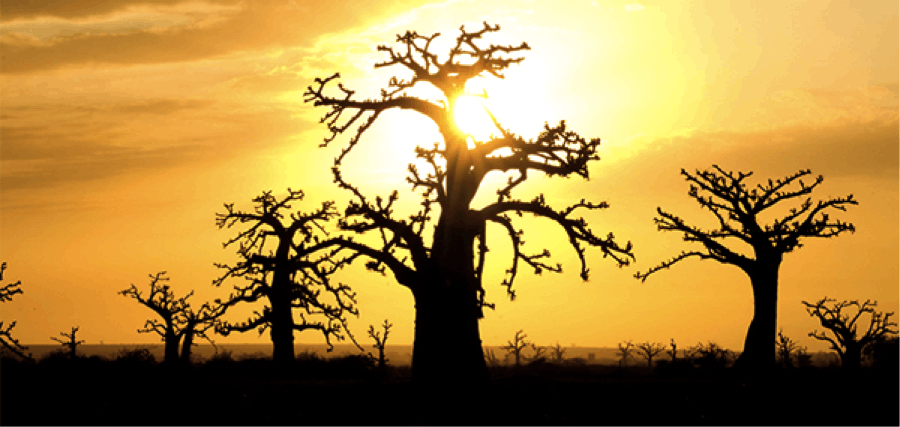
Range
The northern limit of its distribution in Africa is associated with rainfall patterns; only on the Atlantic coast and in the Sudan does its occurrence venture naturally into the Sahel. On the Atlantic coast, this may be due to spreading after cultivation. Its occurrence is very limited in Central Africa, and it is found only in the very north of Southern Africa. In Eastern Africa, the trees grow also in shrublands and on the coast. In Angola and Namibia, the baobabs grow in woodlands, and in coastal regions, in addition to savannahs. It is also found in Dhofar region of Oman and Yemen in the Arabian Peninsula, Western Asia. This tree is also found in India, particularly in the dry regions of the country.[8]
The Baobab is native to most of Africa, especially in drier, less tropical climates. It is not found in areas where sand is deep. It is sensitive to water logging and frost.[9] More specifically: Mauritania, Senegal, Guinea, Sierra Leone, Mali, Burkina Faso, Ghana, Togo, Benin, Niger, Nigeria, N-Cameroon, Chad, Sudan, Congo, D.R.Congo (Zaire), Eritrea, Ethiopia, S-Somalia, Kenya, Tanzania, Zambia, Zimbabwe, Malawi, Mozambique, Angola, Sao Tome, Principe Isl., Annobon Isl., Java (introduced), Nepal (introduced), Sri Lanka (introduced), Philippines (c), Jamaica (introduced), South Africa (Transvaal), Namibia, Botswana, Puerto Rico (introduced), Haiti (introduced), Dominican Republic (introduced), Venezuela (introduced), Seychelles (introduced), Madagascar (introduced), Comores (introduced), India (introduced), Yemen (SW-Yemen), Oman (Dhofar), China (introduced) (Guangdong (introduced), Fujian (introduced), Yunnan (introduced)) [10]
Growth
_in_Hyderabad_W_IMG_8271.jpg)
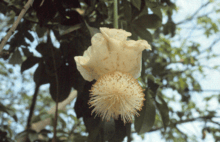
The trees usually grow as solitary individuals, and are large and distinctive trees on the savannah, in the scrub, and near settled areas, with some large individuals living to well over a thousand years of age.[11] The tree bears very large, heavy, white flowers. The showy flowers are pendulous with a very large number of stamens. They carry a carrion scent and researchers have shown that they appear to be primarily pollinated by fruit bats of the subfamily Pteropodinae. The fruits are filled with pulp that dries, hardens, and falls to pieces which look like chunks of powdery, dry bread.[12]
The specific epithet digitata refers to the fingers of a hand, which the five leaflets (typically) in each cluster bring to mind.
Food uses and nutrition
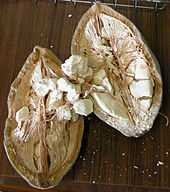
The baobab is a traditional food plant in Africa, but is little-known elsewhere. The vegetable has been suggested to have the potential to improve nutrition, boost food security, foster rural development, and support sustainable land care.[13]
The African baobab's fruit is 15 to 20 centimetres or 6 to 8 inches long. It contains 50% more calcium than spinach, is high in antioxidants, and has three times the vitamin C of an orange.[14] It is sometimes called a superfruit.[14] The dry pulp is either eaten fresh or dissolved in milk or water to make a refreshing drink. The leaves can be eaten as relish. Young fresh leaves are cooked in a sauce, and sometimes are dried and powdered. The powder is called lalo in Mali and sold in many village markets in Western Africa. Oil extracted by pounding the seeds can be used for cooking but this is not widespread.[15] In Sudan — where the tree is called tebeldi — people make tabaldi juice by soaking and dissolving the dry pulp of the fruit, locally known as gunguleiz.[16][17]
In 2008, the European Union approved the use and consumption of baobab fruit as an ingredient in smoothies and cereal bars.[18]
The United States Food and Drug Administration granted generally recognized as safe status to baobab dried fruit pulp as a food ingredient in 2009.[19]
Baobab leaves are sometimes used as forage for ruminants in dry season. The oilmeal, which is a byproduct of oil extraction, can also be used as animal feed.[20]
Prominent specimens and protection
The baobab is a protected tree in South Africa.[21] Several individual baobab trees are notable for their age, their size, or their specific history:
- Glencoe Baobab near Hoedspruit, South Africa
- Ombalantu baobab tree in Outapi, northern Namibia
- Sagole Baobab near Tshipise, South Africa
- Sunland Baobab near Modjadjiskloof, South Africa
- the Toilet Tree in Katima Mulilo, Namibia
Conservation Status and Threats
As of April 2015 from the IUCN Red List criteria, baobabs are not yet classified, but they are a part of the “Catalogue of Life.” [22]
Although this species is not classified. It is an extant species and is found in wide ranges. [23]
Legends and Myths
Along the Zambezi, the tribes believe that Baobabs were upright and too proud. The gods became angry and uprooted them and threw them back into the ground upside-down. Evil spirits now cause bad luck to anyone that picks up the sweet white flowers. More specifically, a lion will kill them. [24]
In contract some people think that if one drinks from water in which Baobab seeds have soaked, you will be safe from crocodile attacks.
In Zambia, one baobab is said to be haunted by a ghostly python. A long time ago, the python lived in the hollow trunk and was worshipped by the natives. A white hunter shot him down, and led to bad consequences. Some nights, the natives still hear the hissing of the snake.[25]
In Kafue National Park, one of the largest Baobabs is known as “Kondanamwali” or the “tree that eats maidens.” The tree fell in love with four beautiful maidens. When they reached puberty, they made the tree jealous by finding husbands. So, one night, during a thunderstorm, the tree opened its trunk and took the maidens inside. Interestingly enough, a rest house has been built in the branches of the tree. On stormy nights, the crying of the imprisoned maidens can still be heard.[26]
Along the Limpopo River, it is thought that when a young boy is bathed in the water used to soak baobab bark, he will grow up into a big man. [27]
Some natives believe that women living in kraals (where baobabs are plenty) have more children. This is scientifically accurate because those women have more access to filling in gaps in their diet with the tree’s vitamins. [28]
The African bushman legend states that Thora, the god, took a dislike to the Baobab growing in his garden, so he threw it over the wall of Paradise onto the Earth below. The tree landed upside down and continued to grow. [29]
References
- ↑ http://www.baobab.com/tag/michel-adanson/
- ↑ http://www.powbab.com/pages/the-baobab-tree
- ↑ http://eol.org/pages/584789/overview
- ↑ http://www.krugerpark.co.za/africa_baobab.html
- ↑ http://www.powbab.com/pages/the-baobab-tree
- ↑ http://eol.org/pages/584789/overview
- ↑ http://eol.org/pages/584789/overview
- ↑ "Adansonia digitata:Plant Database of India". Retrieved 2011-03-21.
- ↑ http://eol.org/pages/584789/details
- ↑ http://www.catalogueoflife.org/col/details/species/id/21510518
- ↑ Varmah, J. C.; Vaid, K. M. (1978). "Baobab - the historic African tree at Allahbad". Indian Forester 104 (7): 461–464.
- ↑ National Research Council (January 25, 2008). "Baobab". Lost Crops of Africa: Volume III: Fruits. Lost Crops of Africa 3. National Academies Press. ISBN 978-0-309-10596-5. Retrieved July 15, 2008.
- ↑ National Research Council (October 27, 2006). "Baobab". Lost Crops of Africa: Volume II: Vegetables. Lost Crops of Africa 2. National Academies Press. ISBN 978-0-309-10333-6. Retrieved July 15, 2008.
- ↑ 14.0 14.1 Claire Soares 2008. The tree of life (and its super fruit), The Independent, Thursday, 17 July 2008
- ↑ Sidibe, M.; Williams, J. T. (2002). Baobab - Adansonia digitata (PDF). Southampton, UK: International Centre for Underutilised Crops. ISBN 0854327762.
- ↑ "Baobab (Adansonia digitata L.): a Review on a Multipurpose Tree with Promising Future in the Sudan" (PDF). Gartenbauwissenschaft. April 2002.
- ↑ http://link.springer.com/article/10.1007%2Fs10722-013-9964-5
- ↑ "Baobab dried fruit pulp". Advisory Committee on Novel Foods and Processes. 2008. Archived from the original on 2008-06-03.
- ↑ Laura M. Tarantino (July 25, 2009). "Agency Response Letter GRAS Notice No. GRN 000273". FDA.
- ↑ Heuzé, V.; Tran, G.; Bastianelli, D.; Archimède, H. (January 25, 2013). "African baobab (Adansonia digitata)". Feedipedia.org. A programme by INRA, CIRAD, AFZ and FAO. Retrieved February 6, 2013.
- ↑ "Protected Trees" (PDF). Department of Water Affairs and Forestry, Republic of South Africa. 3 May 2013.
- ↑ http://www.catalogueoflife.org/col/details/species/id/21510518
- ↑ http://eol.org/pages/584789/overview
- ↑ http://www.krugerpark.co.za/africa_baobab.html
- ↑ http://www.krugerpark.co.za/africa_baobab.html
- ↑ http://www.krugerpark.co.za/africa_baobab.html
- ↑ http://www.krugerpark.co.za/africa_baobab.html
- ↑ http://www.krugerpark.co.za/africa_baobab.html
- ↑ http://www.krugerpark.co.za/africa_baobab.html
External links
| Wikimedia Commons has media related to Adansonia digitata. |
| Wikispecies has information related to: Adansonia digitata |
- Description and cultural information
- Structured description
- PROTAbase on Adansonia digitata
- Feedipedia on Adansonia digitata
- Adansonia digitata in Brunken, U., Schmidt, M., Dressler, S., Janssen, T., Thiombiano, A. & Zizka, G. 2008. West African plants - A Photo Guide. www.westafricanplants.senckenberg.de.
